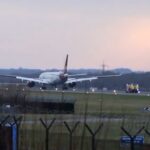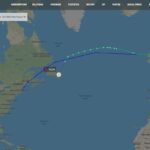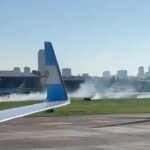North Korea scrambled fighter jets on Thursday in response to a U.S. reconnaissance airplane that allegedly crossed the maritime Military Demarcation Line (MDL), according to North Korean media.
The DPRK’s senior military leadership is now considering deploying warships with anti-aircraft missiles 280 miles (450 km) from Wonsan, the country’s main eastern port to prevent additional “unauthorized invasions of U.S. strategic reconnaissance planes,” the Korean Central News Agency (KCNA) reported Friday.
“This is a new development,” North Korea military expert and co-founder of the Oryx military blog Joost Oliemans told NK News, noting that “no North Korean navy ships are known to deploy surface-to-air missiles (SAMs) that would be a threat to adversary reconnaissance planes.”
However, Oliemans said that there are few candidates for potential DPRK ships with SAMs “that realistically could be deployed for an extended period on the open seas.”
According to North Korea, the U.S. reconnaissance plane infiltrated North Korea’s economic zone nine miles (14 km) deep, “repeatedly circling” over the East Sea (Sea of Japan). The incursion allegedly took place between 5:38 a.m. and 6:37 a.m. on the 17th, some 323 miles (520 km) east of Wonsan to 267 miles (430 km) east of Tanchon.
The U.S. plane allegedly retreated at 7:15 a.m. after DPRK planes from its Eastern Anti-Aircraft Division approached.
KCNA reported that North Korea will not hesitate to take military action in response to defend its territory.
But Tal Inbar, an Israeli-based missile researcher, told NK News the region is likely still “far from an exchange of actual military strikes.”
“The DPRK wants to remind other parties in the region that they are a formidable military power that must be taken seriously. The cost of miscalculated steps (on both sides) might be severe, so alarming messages could be a replacement to some kind of kinetic response,” Inbar explained.
Daniel Pinkston, a Seoul-based lecturer in international relations at Troy University, agreed. “I think it’s empty talk and propaganda,” Pinkston said, adding that the U.S. military is unlikely to “put the aircraft in serious danger of getting shot down.”
According to KCNA, the alleged U.S. incursion comes just 20 days after U.S. airplanes last invaded its airspace. In early July, North Korea also accused the U.S. of intruding, with the DPRK leader’s sister Kim Yo Jong warning that a “shocking incident” will “inevitably” occur if U.S. spy planes operate in North Korean airspace east of the peninsula.
At the time, South Korea’s Joint Chiefs of Staff denied North Korea’s accusation, stating the U.S. reconnaissance flights were “standard” and did not intrude on the North’s territory.
North Korea’s warning to deploy anti-aircraft assets in its waters came as the U.S., South Korea and Japan announced enhanced security cooperation against “grave threats” by the DPRK during their trilateral summit at Camp David on Friday.
North Korea has not yet reacted to the summit’s outcome, but could respond to the three countries’ efforts to bolster military cooperation by conducting a long-range missile launch, Seoul’s intelligence agency said Thursday, citing related military movements in the country.






